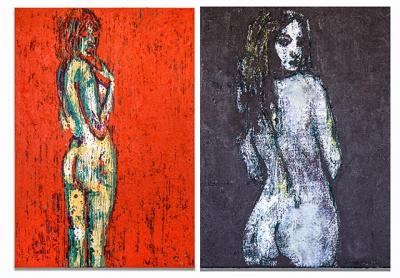Models Steeped in Amber at Harper's Books

When Enoc Perez last took over the walls of Harper’s Books in East Hampton, he filled the space with prints of found photographs of scantily clad women whose modesty was mostly protected by floating colorful shapes collaged on top of them.
The forms appeared to be excised straight from abstract masterpieces by artists such as Henri Matisse, Pablo Picasso, and even Marcel Duchamp. It was like an early modernist peep show.
Now Mr. Perez returns with a kind of revival of the theme with completely different aims and mediums with “Nudes,” an exhibition of 15 paintings at Harper’s on view through Oct. 15.
The women subjects have a nostalgic look with hairstyles and staged posing that seem from another era. Paired with his process, which creates paintings with the look and feel of German Expressionism’s woodcut prints, these works seem more like weathered antiques found in an excavation than contemporary paintings.
It is worth describing the technique, which involves making an image on paper, applying oil paint thickened with a gritty material on the back of that sheet and applying it to a canvas that has been prepared with painted marks or gold or silver leaf. Once the back of the paper is on the surface of the front of the canvas, he retraces the image from the front of the paper to make an image on the canvas.
The resulting forms have blunt lines, indistinct features, and an overall crude style. There is something a bit mysterious about them, even though he renders the figures clearly enough to show their expressions, poses, and body parts. The prepared ground that becomes their flesh can almost look like newsprint, which also muddles the presentation. It is hard to fathom what one is looking at here.
Some canvases offer intensely saturated color fields that surround the figures. An acid Kelly green, electric aqua, fiery orange, and a pinkish red are some of the colors he chooses for the backgrounds. They are densely applied with his gritty impasto. Other canvases are kept very spare and dark, like a traditional woodcut.
The gallery noted that Mr. Perez has painted “iconic modernist buildings, ranging from Philip Johnson’s Lipstick Building to Gordon Bunshaft’s Lever House, in which he rendered an alternate history of power and ambition in the United States and abroad.” It suggests that these female forms “serve as a kind of foil to the muscle and desire treated in his pictures of buildings.”
It raises the question as to whether these are parallel series, particularly when the organizers note that the poses seem to recall centerfolds of the 1950s and 1960s, around the same time some of the buildings he has used as subjects were erected. Although it is easy enough to find the other series on the internet, a show with the two series together would be worthwhile. Mr. Perez’s surfaces reward firsthand interaction and do not translate all that well in reproduction. They are legible, but they don’t indicate the depth of color or the topography of the surface he creates. Something is definitely lost in translation.
Many of those architecture paintings do concentrate on the tall projectiles of the International School and beyond, but there are some flat, low buildings and other rounded feminine shapes. Playing off each piece’s comparative yin and yang would create an interesting energy, somewhat disembodied, but electric nonetheless.
In this room, alone, the women look a bit like they are in suspended animation. The artist presents them in his own kind of amber, a harkening back to bygone days, but his aim remains mysterious.
